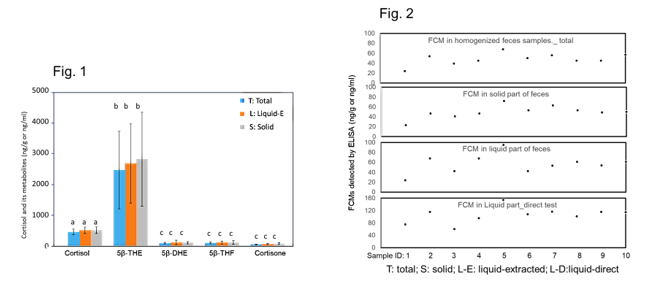VALIDATION OF DIRECT MEASUREMENT OF FECAL CORTISOL METABOLITES IN ATLANTIC SALMON Salmo salar USING A COMMERCIAL ELISA KIT
Introduction:
Atlantic salmon farming represents a cornerstone of Norway’s aquaculture sector, with a production output of 1.6 million tons in 2021. Ensuring high standards of fish welfare is essential to support the industry’s sustainable development. Compared to traditional plasma cortisol measurements, the assessment of fecal cortisol and its metabolites (FCMs) offers a less invasive and more efficient approach for evaluating the health and welfare of salmonids. This method not only reduces handling related stress but also supports long-term sustainability in aquaculture practices.
The primary aim of this study is to evaluate the performance of four commercial ELISA kits for quantifying FCMs in Atlantic salmon (Salmo salar), and to further investigate the distribution of FCMs across the liquid, solid, and homogenized total fractions of fecal samples.
Material and methods:
Atlantic salmon used in this study were reared at a commercial fish farm located on the northwestern coast of Norway. Fecal samples were collected both prior to and 24 hours after sea lice counting procedures conducted in a commercial sea cage. Samples were obtained via stripping and partially subjected to centrifugation to separate liquid and solid fractions. FCMs were analyzed using two methods: enzyme-linked immunosorbent assay (ELISA) and liquid chromatography–tandem mass spectrometry (LC–MS/MS).
Results:
Biological validation demonstrated that both the Cayman and Neogen kits detected biologically meaningful changes in FCMs following stress induced by sea lice counting procedures and handling. Analytical validation demonstrated high accuracy, reliability and reproducibility of both kits. The specificity test revealed that the Neogen kit exhibited relatively higher cross-reactivity to cortisol and its metabolites compared to the other kits. Cortisol and four of its metabolites (5β-THF, cortisone, 5β-DHE, 5β-THE) have previously been identified as reliable stress biomarkers in farmed Atlantic salmon. In this study, all five compounds were successfully detected in the total, liquid, and solid fecal fractions using LC–MS/MS. Analysis revealed no significant differences in the concentrations of FCMs across the three fecal components (Fig.1). Strong correlations were found among the sample types (p<0.05), indicating consistent distribution of these biomarkers. Similar patterns were observed when concentrations were measured using ELISA, with values across the fecal fractions remaining consistent (Fig.2). FCM concentrations determined via ELISA showed a strong positive correlation with LC–MS/MS measurements (p<0.05), although the LC–MS/MS technique consistently produced higher values (p<0.05). Moreover, the FCM concentrations measured directly from the liquid fecal fraction using ELISA without prior extraction correlated well with the results obtained from extracted samples (p<0.05; Fig.2).
Conclusion:
In conclusion, these findings emphasize the need for thorough validation of ELISA kits prior to their application in stress monitoring. Among the kits tested, the Neogen ELISA kit demonstrated reliable performance for quantifying FCMs in Atlantic salmon. The study also confirmed that FCMs are uniformly distributed between the liquid and solid components of fecal samples. While LC–MS/MS remains the more precise and sensitive method for FCMs analysis, ELISA provides a practical and accessible alternative for routine use in most laboratories. Notably, FCM concentrations measured by direct ELISA analysis reflected those obtained using LC–MS/MS, supporting its utility for non-invasive stress assessment in aquaculture settings.
